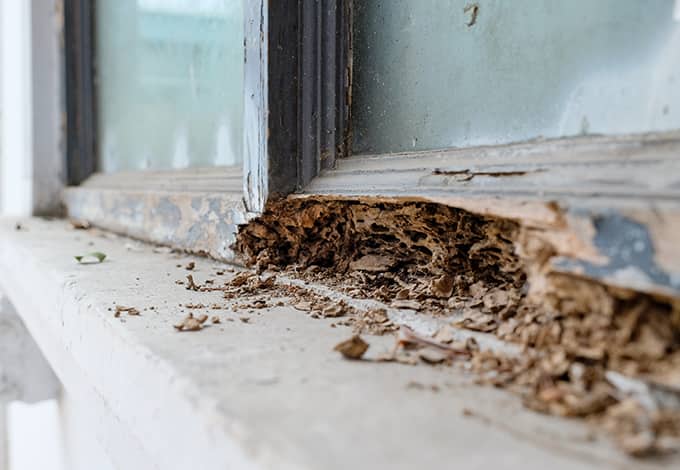

What Do I Have? Carpenter Ants Or Termites?
Let's Start With The Swarmers
Most homeowners don't even realize that the appearance of ant and termite swarmers usually indicates that a mature colony is already living in their walls. They wonder how all these winged insects found their way inside and start looking for a way to seal things up. Some even believe that winged ants are a species of ant instead of seeing them for what they are: winged reproductives. There are many jobs in an ant colony. Some ants are workers, some are soldiers, and some are made to reproduce. The same is true for termites.
If you're finding winged ants or termites on the inside of your windows, there are a few things you need to know about them. Those winged reproductives didn't get inside; they're already inside. You also need to know that they aren't on your windows because the nest is in that wall. Swarmers have only one purpose, and that is to start a new nest. That means that the mature nest inside your walls is trying to produce more nests inside your home.
Though these two swarmers behave similarly and are both breed to mate and form a new nest, carpenter ants and termites are not created equal. When it comes to causing damage, termites are the clear winner. That is why it is important to tell them apart. Here are the three main ways these two wood chewers are different.

Physical:
Termites and carpenter ants are both insects. That means they both have two antennae, six legs, three body parts, and the winged members have two pairs of wings. But these similarities are also what helps to differentiate them.
Antennae
Though both have two antennae, they do not look the same. Termite antennae are straight and appear as if they are made of tiny balls. Carpenter ant antennae have more of a stick-like quality to them and a sort of elbow joint in the middle that gives them a bend.
Body parts
Both of these insects have three body parts, but only the carpenter ant has a waist that tapers. The thorax and the abdomen of the termite look as if they are one. The waist is also an area of the carpenter ant that distinguishes it from other ant species. If you have big black ants and wonder if they are carpenter ants, look to the waist. Carpenter ants have a tiny, round node between their thorax and abdomen. Other ants species that infest homes either have two nodes or no nodes at all.
Wings
Carpenter ants and termites have two pairs of wings, but termite wings stack on top of each other, making them look like one big white wing. Ant wings can always be distinguished as left and right sides by looking at the hind section with a notable cleft between the sets.
You can also tell these two insects apart by their color. Many carpenter ants have a reddish tint to them. Termite swarmers appear jet-black. If your carpenter ants happen to be jet black, you'll notice it more. The white wings on those termites are the predominant color because they are five times larger than the termite's body looking down on these insects. Termite workers, another termite group you might encounter in an infested home, are creamy-white in color.
Appetite:
Termites are wood eaters that dine on the cellulose found in wood products. On the other hand, Carpenter ants eat a variety of things, like pet food, meats, syrup, honey, sugar, jelly, fruit, and other sweets. They do not eat wood but rather excavate the wood to create galleries for nesting.
Cost:
In the grand scheme, the most important difference between these two pests is that carpenter ants cost U.S. homeowners hundreds of millions of dollars each year while termite property damage is in the billions. You should always seek the assistance of a professional pest control company if you find swarmers in your house, but termite swarmers should be dealt with immediately. An average termite colony is between 100,000 - 1 million, but it is not uncommon to find a colony with 10 million or more. A Formosan subterranean termite colony was found in a library in Algiers, Louisiana containing over 70 million termites and weighed approximately 600 pounds. This is not something you want in your walls.
If you have termite swarmers or have noticed other termites, don't wait to have your home treated by termite control professionals. If you have carpenter ants swarmers, don't wait too long. Over time, carpenter ants can also do a significant amount of damage. Contact Parkway Pest Services today.
Customer Testimonials
-
Excellent, prompt, and courteous service. The technician arrived on time and took care of our yellowjacket nest and carpenter bee problems. Highly recommend Parkway if you have pest issues.- Jeff R.
-
Professional, knowledgeable, and great service. The technicians are always on time and the pest issues are solved within a couple of days. Highly recommend Parkway Pest Services for any pest problem. Thank you!- Jean R.
-
Parkway Pest Services responded very quickly to our request to have a tech come and inspect our rodent issue. They provided excellent service, outlining steps they would take as well as the steps we should take. Our pest situation has been resolved! I highly recommend them!- Robert M.
-
“Beyond friendly and professionally she really understood how freaked out we were and felt like she was in it with us the whole way.”- Emily W.
-
“The gentlemen that came over was very friendly and honest!”- Patty M.
-
“They sent a tech the same day and truly saved the day for my Aunt’s home in New York.”- D. Hunsaker
-
“I called Parkway, got Shoshanah on the phone, told her about the problem (she could tell I was a wreck!) Within an hour Steve was here!”- C. Petronella
-
“Had some scheduling issues and with her kindness patience and professionalism sorted it all out!”- John D.


Our Blog & News
Catch up with the latest blog articles from Parkway or see news that is happening in the pest control industry.







